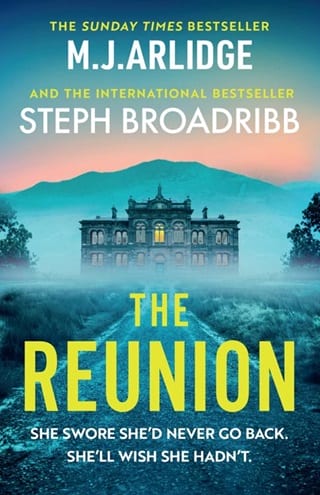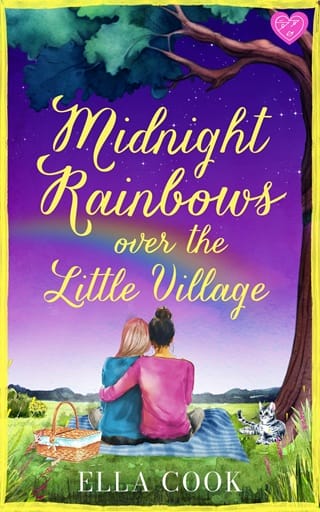Chapter 34
Chapter 34
It’s hopeless.
Jennie lies in bed in the darkness of the guest bedroom, thoughts of Martin kissing her repeating in her mind over and again. The way he pushed her against the door, trapping her. How he gripped the back of her neck, forcing her mouth to his. The feel of his tongue thrusting into her mouth, uninvited.
What the hell was he thinking? Why did he think I wanted that?
He said she’d been giving him the come-on, but she’s sure she hadn’t given any indication of wanting anything more than a professional relationship. There’s never been anything like that between them. Although, thinking back, years ago when he’d first joined the station he had made a joke about asking her on a date. But it was just a joke. They’d all laughed. Him kissing her makes zero sense. He made out he was a devoted family man, always talking about his kids and his wife. Was it all bullshit? It must be.
Even though she knows she didn’t lead him on, Jennie feels the doubt starting to crowd her thinking. Had she been too friendly? Too interested in his life, in him? Had she looked at him as if she wanted more?
No.
Bullshit.
She’s certain she did nothing wrong. All the same she feels grubby, guilty almost. Complicit in his attempted infidelity. A witness to a predatory side of Martin that she’s never before seen or had any inkling of.
Picking up her phone from the bedside table, she checks the time. It’s almost midnight, but sleep has eluded her for over an hour and there’s no way she’s going to get to sleep anytime soon. Throwing off the duvet, she gets out of bed and pulls on her old jogging bottoms and sweatshirt. If she’s awake, then she may as well do something.
Jennie pads along the threadbare orange-and-brown-swirled Seventies carpet of the hallway and into her childhood bedroom. Picking up her old Nikon SLR camera, she carries it down the stairs to the kitchen where the photo developing supplies delivered this morning still sit in their box on the table.
She needs something to take her mind off what happened with Martin. And the ritual of the development process always used to feel like a meditation to her; it never failed to quiet her thoughts, even when her mum was at her worst and the grief for her father threatened to become overwhelming.
Jennie always used to listen to Radiohead when she was working in the darkroom. She finds their album Pablo Honey on Spotify and sets it to play on repeat, then opens the window to give some ventilation before unpacking the supplies and laying them out on the kitchen table. The supplies are basic compared to the set-up they’d had in the basement darkroom; there’s no red light here. But they should do the job.
Ready.
The film is half-used. She clicks through until the film reaches its end and the Nikon automatically rewinds it, ready for developing. Jennie removes the film and sets the camera to one side. The first step is tricky. Carefully, with Radiohead urging her on, she migrates her film to the changing bag. She grabs the other equipment she needs for this stage and puts it into the bag as well, then zips it up, ensuring the bag is fully light-safe.
Next, she pushes her hands through the armholes in the bag and locates the film canister, using her can opener to prise one end off. It’s harder than she remembers, but then she’s out of practice and it all has to be done by feel. Removing the film, and taking care only to touch the edges, she cuts off the blank tongue of film at the beginning of the roll, then unwinds the film and cuts it off from the spindle.
Careful not to put fingerprints on the film, Jennie attaches the film onto one of the reels. Holding her breath, she gradually slides the film onto the reel. It’s been years since she last did this, and her rustiness makes her hesitant; she doesn’t want to make a mistake.
Exhaling as she completes the process, Jennie finds the canister pipe and loads the film, using a spacer reel to ensure the film stays in position. Then she lifts the reels into the canister. Once the canister is light-safe, Jennie sets to work mixing her chemicals, preparing her developer, fixer and stop bath. She makes sure the distilled water is at the right temperature, keen to ensure the negatives don’t have mineral spots.
Jennie works through the steps to the rhythm of the music, as if in a trance: developer, stop bath, fixer. When the steps are complete, she carefully removes the film from the developing canister and pulls the film off the reel, carefully using a sponge to absorb some excess water. Using film clips, she pins the negatives to the string she’s rigged up, then sets about tidying the equipment.
She realises quickly that there’s something wrong. The negatives are too washed out and over-exposed to be able to make out what the pictures are supposed to be.
Jennie swears under her breath. It could be the age of the film, or that it’s been sitting in the camera all these years; or it could be that she’s messed up the process. She needs an intensifier to try to bring out more detail. Searching through the rest of the supplies box, she finds a small bottle of hydrochloric acid. She remembers using it a few times in the darkroom at White Cross Academy – it was Elliott’s intensifier of choice.
Carefully, Jennie runs through the process with the acid, hoping as she works that it will rescue her pictures. She’s relieved when the negatives turn out better once she’s finished, the clarity and grain of the images much improved. She can see the pictures are of people, but the negatives are too small to see enough detail and make out who they are.
Jennie should let the negatives air for a few more hours until they’re completely dry, she knows that, but she doesn’t want to wait. Cutting the negatives into strips, she slides them into negative sleeves. She could continue the analogue process and print her own photographs – she’s got the kit to do it. But the manual process will take a while and she’s impatient to see the pictures, so she decides to try a digital shortcut.
Picking up the negative sleeves, she walks out of the kitchen to the cluttered front room. Her laptop is on the sofa and her printer is set up on the console table at the side of the room. She’s pretty sure it has a scanner function, although she’s never used it before.
Switching on the printer, she flicks through the menus until she finds what she’s looking for. There is a scanning function. It’s only black and white, and will be far lower quality than a proper film scanner, but for now it will do to satisfy her curiosity.
Pressing first one and then the other sleeve of negatives onto the glass, Jennie scans them in turn and sends the results to her laptop. Carefully, she removes the negative sleeves from the printer, then walks around to the sofa to collect her laptop and goes back to the kitchen.
She yawns as she walks, tiredness starting to catch up with her. Then puts the laptop on the kitchen table before rehanging the negatives to let them dry more. Yawning again, she makes a coffee to try to perk herself up. She’s determined to go through the pictures before she lets sleep take her.
Opening the laptop, she finds the files and opens the photographs one by one. There are seven images. The first four she recognises as pictures she took on the same day that she’d taken the group photo of the darkroom crew on the sofa; it’s the image used by Lottie on the Facebook group that had caused Jennie all the angst with her DCI. She must have changed the roll of film just after taking the picture, although she doesn’t remember. The images are unposed, reportage style. There’s Elliott hanging up photos on the washing line in the darkroom, still diligently wearing his safety glasses and gloves; there’s Lottie applying her lipstick, Coral Delight, in a handheld mirror; there’s Simon, the basement key on a leather string around his neck, looking like he’s in the middle of a heated debate with Rob; and finally, there’s Hannah, watching the two boys with wry amusement.
Jennie smiles. It had been the last day they’d all been together in the darkroom together. These were the last pictures she took of her friends. Excited to see the rest of the photos, she clicks on the thumbnail images of the remaining three pictures she scanned and waits for them to appear on the screen.
Jesus.
Jennie watches as the picture files open on her laptop. One, two, three.
What the hell?
No way did she take these shots.
As adrenaline chases her tiredness away, she stares at the image now on the screen. It shows Hannah, wearing a black vest top, denim hotpants and her favourite Celtic knot belt buckle, in the darkroom. She’s preening for the camera, but her smile seems different, distorted somehow, and the look in her eyes as she peers over the top of her mirrored shades is almost manic. Jennie has never seen her friend look like this.
There’s a person reflected in the mirrored shades. Zooming in, Jennie’s breath catches in her throat as she realises who it is. It’s Rob, bare-chested and barefooted. He has the same wild look on his face and Jennie’s camera in his hand.
Jennie knows she wasn’t there when this was taken. For one thing, she’d never have allowed Rob to use her camera. And for another, she never saw him without a shirt on. Was this one of the times Hannah and Rob had met up to get high? From their expressions it certainly looks like it could be.
She clicks onto the next picture. It’s blurred and taken at an angle, as if the person holding the camera hadn’t meant to take it, but on the table beside the burgundy sofa she can make out bottles of alcohol – Thunderbird and vodka – and what looks like some smaller objects that Jennie can’t help but presume are drugs.
Jennie feels her heart rate accelerate.
When was this picture taken? Could this have been the night Hannah disappeared? Did Hannah and Rob get high, and something go wrong again, but this time Hannah died? Is Zuri’s theory that Rob is the killer, even if accidentally, correct? Is that why Rob lied about his alibi?
Is that why Hannah never arrived at the bus stop?
As Radiohead’s ‘Creep’ plays on her phone, Jennie clicks onto the final picture.
What the …?
Although not perfect, the focus is better in this one and she easily identifies the people in the shot. Simon, wearing only his boxer shorts and a headband that makes his blond hair stick up at weird angles, is leaning over Lottie, who’s lying on the sofa, and he’s trying to pour vodka from the bottle into her mouth. Elliott is developing negatives in the darkroom behind them, while Hannah looks as if she’s dancing in the space between the sofa and Elliott. Jennie guesses Rob was taking the photo.
The five of them were having a party without her.
Standing up, Jennie moves across to where the negatives are drying and unclips them from the string line. She checks the time stamp on them. Feels the hairs on the back of her neck stand on end.
The last three photographs are date-stamped 06-06-94 and the time taken ranges from 21:49 to 21:57. Hannah disappeared on Thursday 9 June, 1994. All these photos were taken earlier in the week Hannah disappeared.
Jennie feels a stab of jealousy. They were partying without her. Hadn’t she been part of the crew? Why had they excluded her?
As she turns back towards the laptop, preoccupied, Jennie knocks the open bottle of hydrochloric acid with her arm. It tips and she has to move fast to stop it from emptying onto the floor. As she grabs the tipping bottle, some acid splashes onto her hand.
Shit.
Rushing to the sink, Jennie runs the cold water and holds her hand under it, watching as an angry red burn appears on her skin.
Fighting back tears, she wonders if she really knew her so-called friends at all. The more she has discovered through the investigation, the more it’s seemed the answer to the question is no, especially now. The final, soul-crushing lyrics of ‘Creep’ have never felt truer. She didn’t belong there.
Turning off the tap, Jennie looks at the burn on her hand. It hurts, but it’s not so bad that she needs medical attention. Instead, she gets a tube of aloe vera from the cupboard and covers the blistered patch of skin.
Trying to push away the feelings of rejection and exclusion, Jennie switches off the music app. She needs to think about what she’s discovered and how it might relate to Hannah’s disappearance. The house is dead-of-night quiet now, eerily so, but she welcomes the silence. Thoughts about each of her old school friends are ricocheting through her mind. She needs to order them, to try to take her emotions out of it and be objective, logical.
Rob was with Hannah in the photos. He admitted the pair of them were the wildest of the group, far wilder than Jennie ever realised at the time. He was obsessed with Flatliners , which she’d already known, and Simon had told them Rob was always experimenting to try to achieve the next level of consciousness. They had the medical records to prove that Hannah had an accidental overdose while taking drugs with Rob, and Rob had admitted it. He’d said it was a one-off, but the photos Jennie has just found prove that was a lie.
Simon had said Rob and Hannah experimented using neck ligatures to further heighten their drug-induced highs. Given the marks on Hannah’s neck documented in her medical records during the visit with Rob four weeks before her death, Jennie’s inclined to believe him. Rob told them he was at the cinema when Hannah went missing, but they now know that must have been a lie. Was he in the basement, hiding her body instead? Jennie shakes her head. She has so many questions for Rob, but she can’t ask him now he’s dead.
As she thinks, Jennie begins to tidy up the developing kit. She screws the bottle cap back onto the hydrochloric acid, and places it into the kit box, then starts to dismantle and wash the canister, taking care not to splash water on her burn.
Simon had the basement key. He seemed to be lying in the interview and trying to push Duncan Edwards into the spotlight. Perhaps to hide his own guilt? If any of the group were in the darkroom after hours, he’d have to have known – he would’ve had to let them in or lend them the key. Or had he arranged to meet Hannah the night she went missing? Was he angry and jealous that she still wouldn’t have sex with him but was rumoured to be in an inappropriate relationship with Edwards? Was it a crime of passion? Did he kill her in a murderous, jealous rage?
One by one, Jennie dries each part of the canister and puts them into the kit box. She thinks about Elliott, once her best friend after Hannah, and how Simon told them the monthly payments from Elliott are because he feels beholden to Simon for saving his life. Would he be that loyal even if Simon had done something awful like commit murder? Elliott certainly seemed to have been holding back in the interview, and she now knows he is perfectly capable of keeping secrets: he never told her about the trauma he’d been through during the early part of 1994. Was saying Paul Jennings was at the school that night a tactic to divert police attention elsewhere?
As she puts the rest of the chemical bottles back into the kit box, Jennie’s thoughts move to Lottie. They were never the best of friends, but Lottie seemed over-friendly towards her when they met at the reunion on White Cross Hill. Since Hannah’s body was discovered, Lottie has contacted her multiple times. She seems desperate, always wanting to know what’s happening with the investigation. Is it because she’s anxious for Hannah to get justice, or is something more sinister going on? Could it be that Lottie knows what really happened to Hannah and is trying to find out if the police are close to discovering the truth? Was she there when Hannah died; is that why her alibi for the night she disappeared is fake? Could that have been Lottie’s motivation for dropping Jennie in it with the photo revelation?
Jennie rubs her forehead. She’s exhausted now. Folding up the light-safe bag, Jennie places it on top of the kit box and closes the lid. She glances at the cuckoo clock on the wall: it’s almost three-thirty in the morning. She has to get some sleep, or she’ll be useless tomorrow.
Switching off the lights, Jennie climbs the stairs. She’s starting to believe at least one of her friends could have been responsible for Hannah’s death, and it’s messing with her head. But she’s close to the truth now, she can feel it.
She can’t screw this up.
She just can’t .
 Fullepub
Fullepub 



